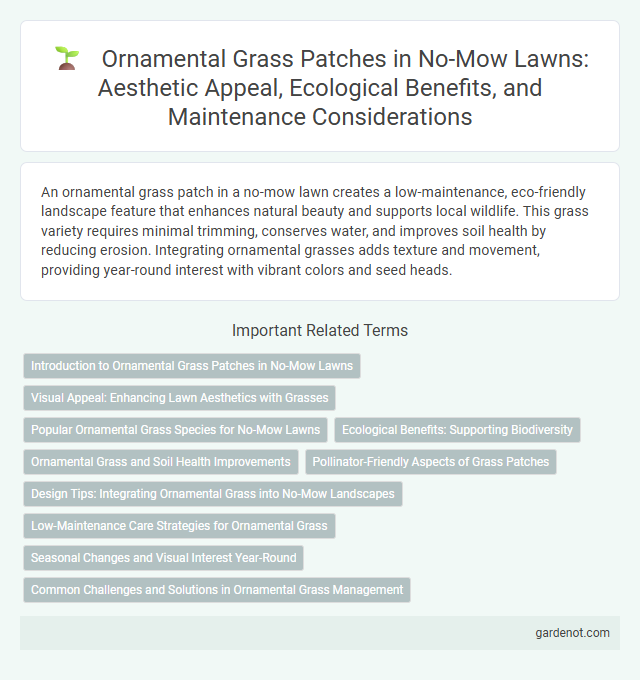An ornamental grass patch in a no-mow lawn creates a low-maintenance, eco-friendly landscape feature that enhances natural beauty and supports local wildlife. This grass variety requires minimal trimming, conserves water, and improves soil health by reducing erosion. Integrating ornamental grasses adds texture and movement, providing year-round interest with vibrant colors and seed heads.
Introduction to Ornamental Grass Patches in No-Mow Lawns
Ornamental grass patches in no-mow lawns create visually appealing, low-maintenance landscapes by using drought-tolerant and hardy grass species such as feather reed grass, blue fescue, and fountain grass. These grasses require minimal watering and virtually eliminate the need for mowing, promoting sustainability and reducing lawn care costs. Integrating ornamental grass patches enhances biodiversity, supports pollinators, and adds texture and movement to outdoor spaces.
Visual Appeal: Enhancing Lawn Aesthetics with Grasses
Ornamental grass patches add dynamic texture and rich color variation to no-mow lawns, creating year-round visual interest. Varieties like blue fescue and fountain grass introduce movement and depth, enhancing the overall landscape design with minimal maintenance. These grasses complement native plants and flowering perennials, boosting biodiversity while elevating the lawn's aesthetic appeal.
Popular Ornamental Grass Species for No-Mow Lawns
Common ornamental grass species ideal for no-mow lawns include Blue Fescue (Festuca glauca), known for its fine texture and drought tolerance, and Fountain Grass (Pennisetum alopecuroides), which adds height and movement without frequent trimming. Prairie Dropseed (Sporobolus heterolepis) offers a graceful, tufted appearance with minimal maintenance, while Carex varieties provide evergreen color and adaptability to various soil types. These species enhance the aesthetic of no-mow lawns by requiring little to no mowing, promoting sustainability and low upkeep.
Ecological Benefits: Supporting Biodiversity
Ornamental grass patches in no-mow lawns provide essential habitats for pollinators and beneficial insects, enhancing local biodiversity. These grasses improve soil health by promoting microbial activity and reducing erosion. Their dense root systems contribute to carbon sequestration and natural water filtration, supporting broader ecosystem functions.
Ornamental Grass and Soil Health Improvements
Ornamental grass patches enhance soil health by promoting better aeration, moisture retention, and microbial activity, resulting in nutrient-rich, resilient soil. The deep root systems of ornamental grasses reduce erosion and improve soil structure, enabling sustainable no-mow lawn solutions. Integrating diverse grass species maximizes ecological benefits while maintaining aesthetic appeal and reducing maintenance needs.
Pollinator-Friendly Aspects of Grass Patches
Ornamental grass patches in no-mow lawns create vital habitats for pollinators by providing essential nectar sources and shelter, enhancing local biodiversity. These grass patches support native bees, butterflies, and other beneficial insects, contributing to the health of surrounding ecosystems. Incorporating diverse, native ornamental grasses maximizes pollinator attraction and promotes sustainable, pesticide-free lawn maintenance.
Design Tips: Integrating Ornamental Grass into No-Mow Landscapes
Incorporating ornamental grasses into no-mow landscapes enhances texture and visual interest while minimizing maintenance. Select drought-tolerant varieties like blue fescue and fountain grass that thrive with minimal irrigation and mowing. Arrange grasses in clusters or borders to create natural movement and contrast against low-growing groundcovers like creeping thyme or sedum.
Low-Maintenance Care Strategies for Ornamental Grass
Ornamental grass patches thrive with strategic low-maintenance care, requiring minimal mowing due to their natural growth patterns. Implementing seasonal pruning and mulching enhances soil moisture retention and reduces weed growth, promoting sustainable health. Selecting drought-tolerant species further minimizes watering needs, making ornamental grasses ideal for eco-friendly landscaping.
Seasonal Changes and Visual Interest Year-Round
Ornamental grass patches in no-mow lawns provide dynamic seasonal changes, showcasing vibrant hues in autumn and lush greenery in spring and summer. Their natural texture and movement enhance visual interest throughout the year, attracting wildlife and creating a low-maintenance landscape. These grasses adapt well to varying weather conditions, ensuring consistent aesthetic appeal with minimal upkeep.
Common Challenges and Solutions in Ornamental Grass Management
Ornamental grass patches often face common challenges such as uneven growth, weed invasion, and pest infestations, which can compromise their aesthetic appeal and health. Implementing strategic solutions like regular thinning, targeted herbicide application, and integrated pest management helps maintain vigorous growth and reduce weed competition. Selecting disease-resistant varieties and ensuring proper watering schedules further enhance the resilience and visual impact of ornamental grasses in no-mow lawn settings.
Ornamental grass patch Infographic

 gardenot.com
gardenot.com